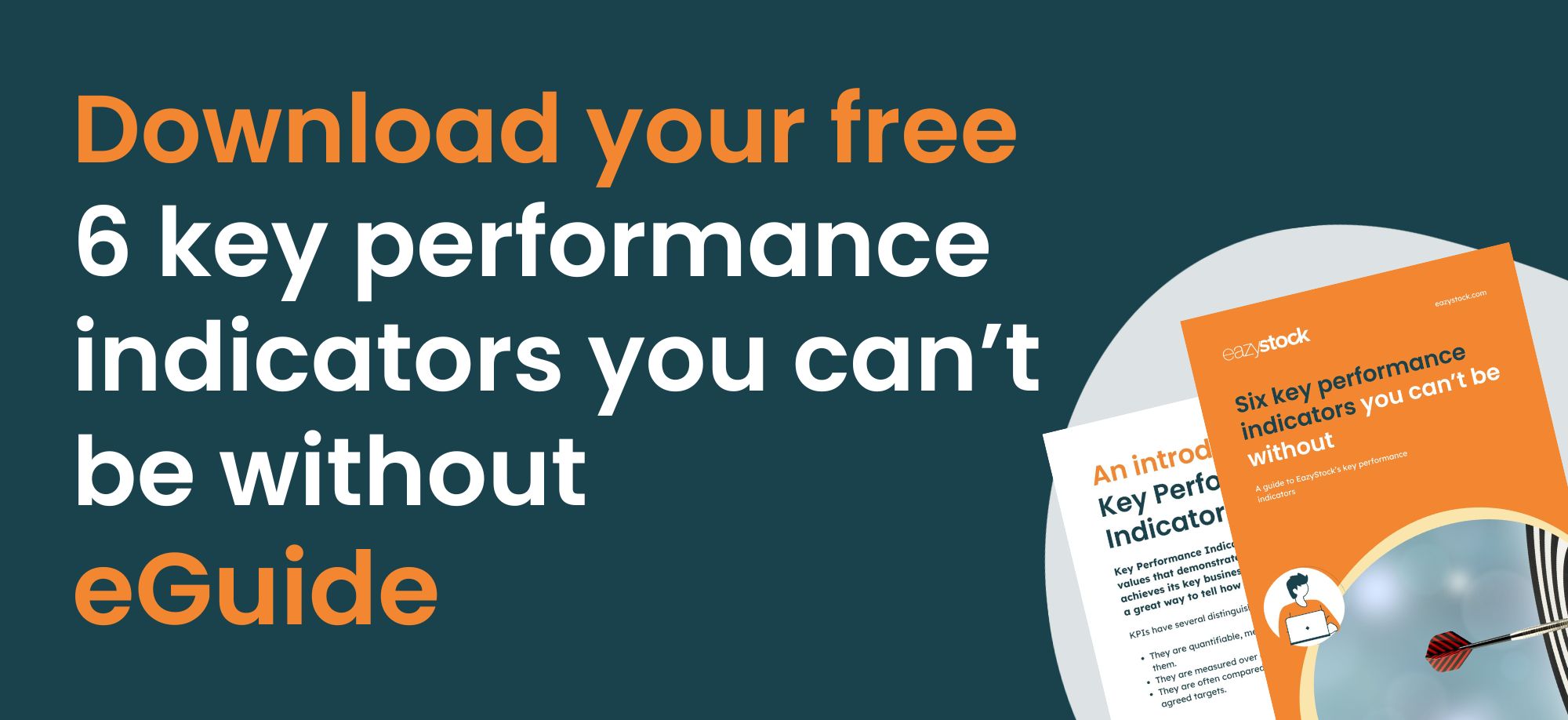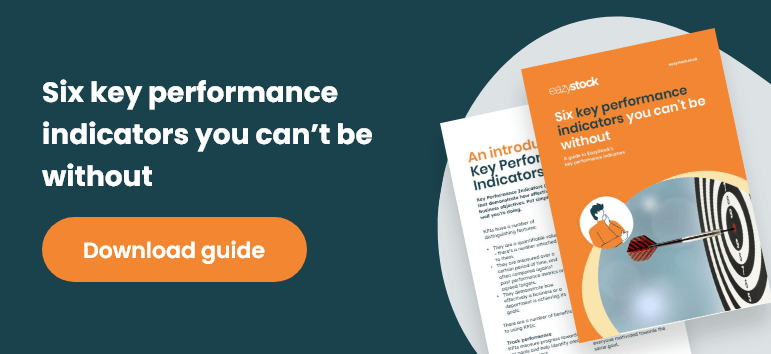10 Inventory management KPIs for 2025
Inventory management KPIs for effective stock management
Managing inventory is a complex business. Lots of activities, processes and people are involved in ordering, receiving, storing, picking and shipping items with the ultimate aim of keeping customers happy with complete orders that are on time.
Inventory management KPIs are essential as they help analyse and track the performance of inventory management activities and eliminate guesswork, e.g. how stock is ordered, managed and turned. With a range of inventory management data, you can measure the progress of supply chain objectives and identify areas for improvement so you can make strategic, data-led decisions.
With so many KPIs available to help manage the performance of your processes, how do you choose the right ones for your business? Which ones will ensure optimum efficiency? Let’s take a look.

What inventory management KPIs should you track?
Every business is different and working toward different targets, but here are some tips for selecting the best ones for you.
- Choose KPIs that will bring value and improve your inventory management effectiveness.
- Align KPIs with your strategic business objectives. For example, improving cash flow, customer service targets, growth strategies or profitability objectives. If you’re planning your objectives, think about what information you’re missing and what questions your board might ask so you can choose KPIs that will provide the answers.
- Don’t limit your focus to the internal environment. Think about your customers and their satisfaction levels so you can ensure their return business.
- Consider whether your inventory management systems have the functionality to provide these KPIs or whether you need to upgrade or invest in additional software.
How to set inventory management KPIs
KPIs need to be SMART – specific, measurable, achievable, relevant, and timely, so avoid setting targets that are too broad and are difficult to quantify and measure. Instead of saying, “We’d like to increase our stock turnover”, it becomes, “We’d like to increase our stock turnover by 2% by the end of this year”.
KPIs will influence how employees carry out their jobs, so ensure the metrics you choose will promote the right collaborative behaviour and avoid any that encourage competition between departments.
Once your KPIs are in place, you need to track and communicate regularly across your business. Your business or inventory management system should be able to help with this. Ensure employees understand the importance of KPIs and how they contribute to their performance. Offer praise when you’re performing well and constructive feedback when performance needs to improve to keep everyone motivated. towards the same goal.
Inventory management KPI examples
1. inventory carrying costs
Inventory carrying costs, or holding costs, include all the overheads (many hidden) you incur by stocking items in your warehouse. These costs include:
- Capital costs – all costs related to the investment in buying stock, e.g. the cost of the stock, the interest on working capital and the opportunity cost of the money invested.

- Storage space costs – a combination of the warehouse rent or mortgage and maintenance costs, such as lighting, heating and air conditioning.
- Inventory service costs – include insurance, security, IT hardware and the cost of physically handling the goods.
- Inventory risk costs – cover the risk of items losing value while stored, shrinkage, or becoming obsolete.
The carrying cost of inventory is calculated by totalling the above overheads and dividing by the average annual inventory cost. Holding costs are expressed as percentages; values typically range from 15-20%.
You can improve this KPI with more efficient warehouse and inventory management processes. If you can keep goods moving through your warehouse and avoid excess inventory and obsolete stock, your carrying cost KPI will be in good shape.
Inventory holding cost = (Storage costs + employee salaries + opportunity costs + Depreciation costs)/Total value of annual inventory
IT’S A TRAP
Old stock isn’t ‘free stock’. Just because it’s been sitting in your warehouse for a while doesn’t mean it’s not costing you anything now. You’re tying up cash that could be spent elsewhere and taking up valuable warehouse space you’re paying for.
2. Days sales of inventory (DSI) and inventory days on hand (DOH)
This shows you how long it takes to turn your inventory into sales, measuring liquidity and efficiency.
(Average inventory/Cost of Goods Sold (COGS)) x 365
Inventory days on hand measures the speed of inventory turnover. The smaller the number, the better, as this means you aren’t holding stock for longer than necessary or wasting money.
Inventory days on hand = (Average inventory for the year/cost of goods sold) x 365
It measures how long stock takes to sell, which indicates how long it takes to release cash. A low days sales value indicates fast stock turnover and can highlight items at risk of stockout.
IT’S A TRAP
Keeping stock for a long time to meet unexpected orders isn’t cost-effective. It takes up space for items that will sell quicker and could become damaged or out-of-date so that it won’t sell. Instead, it will be written off and affect your bottom line.
Combining days on hand with accurate demand forecasts and replenishment strategies allows you to order the stock you need when needed, avoiding literal stockpiles in your warehouse.
3. Inventory turnover ratio
The Inventory turnover ratio measures how quickly stock is sold and replaced (turned over) in a predefined period, usually a year.
A common way to calculate an inventory turnover ratio is as follows:
Inventory turnover ratio = Cost of goods sold/Average inventory value
Average inventory value = (Opening inventory value + Closing inventory value)/2
Inventory turnover is a good indicator of the efficiency of your inventory management processes. A higher turnover generally means greater efficiency. However, be careful not to lower inventory levels across the whole warehouse to improve your turnover rate at the expense of order fulfilment. Read our whitepaper on How to fix inventory turnover challenges for more tips.
IT’S A TRAP
If you buy 500 units and only sell 100, that’s slow, stagnated turnover. In the same way that high days sales values affect your bottom line, consider the cost of those extra 400 units.
Efficient processes or automation enable you to handle more frequent ordering. This allows you to carry less stock, reducing carrying costs and improving your turnover ratio.
4. Backorder rate
The backorder rate KPI keeps track of the number of delayed orders due to stockouts. It shows the percentage of customer orders that cannot be filled at the time of placing.
If your orders often include multiple lines and shipments, you can also drill down into the actual line orders for more accuracy.
A high backorder rate can indicate poor demand forecasting and planning and affect customer satisfaction. It is calculated as:
Backorder rate = (Number of undeliverable orders/total number of orders)/100
IT’S A TRAP
Backorders aren’t guaranteed sales. If you can’t fulfil an order for a customer and you order in the extra for them, there’s no guarantee they’ll come back for the rest. In fact, up to 40% of customers might look elsewhere for the remaining items.
5. Order cycle time
Order cycle time is a valuable inventory management KPI. It measures the time between a customer placing and receiving an order. This isn’t the same as lead time, which is the time between placing and receiving the order – it relates to the customer’s order. The lead time could make up part of the order cycle time.
By analysing this KPI, you can understand how efficiently you prepare and process orders. The shorter the time it takes for the customer to receive the order, the better, as they will be more satisfied and likely to return.
However, replenishment can be restrained by suppliers’ ordering stipulations regarding order frequency and minimum order quantity.
IT’S A TRAP
Loyal customers won’t wait for your stock if they can get it from someone else. Time is money, and if your lead time is too long, they will find someone else who can get it to them quicker. Even if they say it’s just this one order, if a competitor provides a better service, you could lose them.
6. Demand forecast accuracy
Aiming to get your demand forecasting as accurate as possible is critical to ensure stock availability, maximise sales and keep customers happy while preventing excess stock.
This KPI analyses how accurate your forecast was against actual sales. The smaller the gap between what was forecasted and what was sold, the more accurate your demand forecasting. Accurate demand forecasts improve your inventory turnover rates and lower your carrying costs.
There are many formulas for calculating demand accuracy, or demand error, including the Mean Absolute Percent Error (MAPE) and Mean Absolute Deviation (MAD), which we explain in more detail in our blog post on calculating forecast error.
If you’re struggling with demand forecasting accuracy due to the limited functionality of your enterprise resource planning system, you should consider investing in inventory optimisation software. An inventory optimisation ERP plug-in will not only dynamically forecast your demand but also provide data on the accuracy of your forecasts and adapt them for the future.
IT’S A TRAP
Rolling average forecasts in Excel don’t work in the real world. We don’t live in a perfect world of consistent demand. Economic circumstances constantly change, and if your forecasts don’t consider trends, seasonality, promotions and other factors, they won’t be accurate. Your replenishment will be wrong, and you’ll end up with the wrong stock quantities.
7. Stock-to-sales ratio, inventory-to-sales ratio
The stock-to-sales ratio checks the health of your stock levels by comparing how much inventory you have available to sell against what you have already sold.
You can use this ratio to adjust your stock levels so they are continuously optimised to reduce holding costs, improve cash flow, maintain high margins and reduce the possibility of stockouts.
Stock to sales ratio = average inventory value/net sales value.
The inventory-to-sales ratio provides the remaining inventory at the end of the month after the sales you made. Highlighting rising stock levels against falling sales helps you adjust replenishment and ordering to prevent potential cash flow issues.
It also helps you calculate replenishment quantities to meet demand forecasts without using backorders.
EOM inventory balance/Sales for the month
IT’S A TRAP
You might think having stock left at the end of the month is a good idea to meet unexpected orders, but if this happens every month, it will soon add up. It’s much better to use realistic safety stock levels with accurate demand forecasts to ensure you hold optimal stock levels.
8. Inventory shrinkage
Measuring shrinkage allows you to quantify inventory loss from theft, damage or error to see inventory order accuracy and control issues. It prevents you from listing items you don’t have available or can’t sell.
(Record inventory – actual inventory)/Recorded inventory x 100
IT’S A TRAP
For every unaccounted unit, you’re throwing away money. You need to monitor inventory levels frequently to ensure you aren’t promising items you don’t have and pushing customers to competitors.
9. Sell-through rate
The sell-through rate compares the total inventory sold with the total inventory received from a supplier. This can help you understand your demand forecasting accuracy, highlight popular products, and mitigate storage costs, all of which help to understand supply chain efficiency.
Sell-through rate = (units sold/units received) x 100
IT’S A TRAP
Good supplier relationships are essential in delivering good service. Understanding where you’re over- or under-ordering means you can enhance those relationships by providing more accurate sales orders. You can then avoid rush orders that put you and your suppliers under unnecessary stress.
10. Service level
At EazyStock, we believe that service level is one of the most critical inventory KPIs you can analyse and track as it closely correlates with customer service.

Service level measures whether an inventory item was out of stock when requested for delivery, leading to an unfulfilled order or if the sales order could be met from inventory on hand.
Any out-of-stock item, even one SKU, will lead to an incomplete order, harming customer satisfaction.
Initially, you should set your desired service level based on how essential the stock item is to your business (how much revenue or profit it makes) and its forecasted demand and volatility level. For example, profitable products that constantly sell well should have a high service level of around 99%, while unprofitable goods with intermittent demand could have a lower service level of around 85%. Read our blogs to learn how to use ABC analysis or other inventory classification models for this.
Once you’ve set your service levels, track them as order transactions occur and report on the actual figure against the target.
An advanced inventory management system like EazyStock uses more complex algorithms to set service-level targets. Along with the variables above, the lead time of the SKU is also considered, using supply and demand factors to calculate whether orders will be met.
EazyStock then uses service level targets to set inventory parameters, such as reorder points, safety stock and order quantities, to ensure demand can be fulfilled and minimise the stockout risk.
IT’S A TRAP
Say a customer wants to buy 60 items from you, but you only have 30 in stock. If they buy all 30 items, that’s not 100% service level. That’s a 50% loss. They still don’t have the 30 items they need, so they will buy them from someone else.
Inventory management KPIs that will optimise stock levels
There are many KPIs that you can use to analyse your stock management efficiency, and in this blog post, we’ve discussed ten that we see most commonly used. However, ensure you choose the ones that best suit your business needs so you’re tracking useful information that can help you improve your inventory management processes and efficiencies.
The most important inventory KPIs show how well you optimise your stock levels. Stockouts and, adversely, excess stock cause many problems for businesses, from financial concerns to marketing catastrophes.
Inventory optimisation KPIs focus your analysis on how well you’re meeting demand whilst managing stock levels to prevent over- and under-stocking. We delve further into six key inventory management KPIs in our eGuide.
To improve this number (or make it easier to manage), use an inventory tracking system to track your inventory levels and sales orders in near real-time.
If you’d like to know more about EazyStock inventory optimisation software and how it can help support you with inventory KPI setting, tracking and management, please get in touch.










